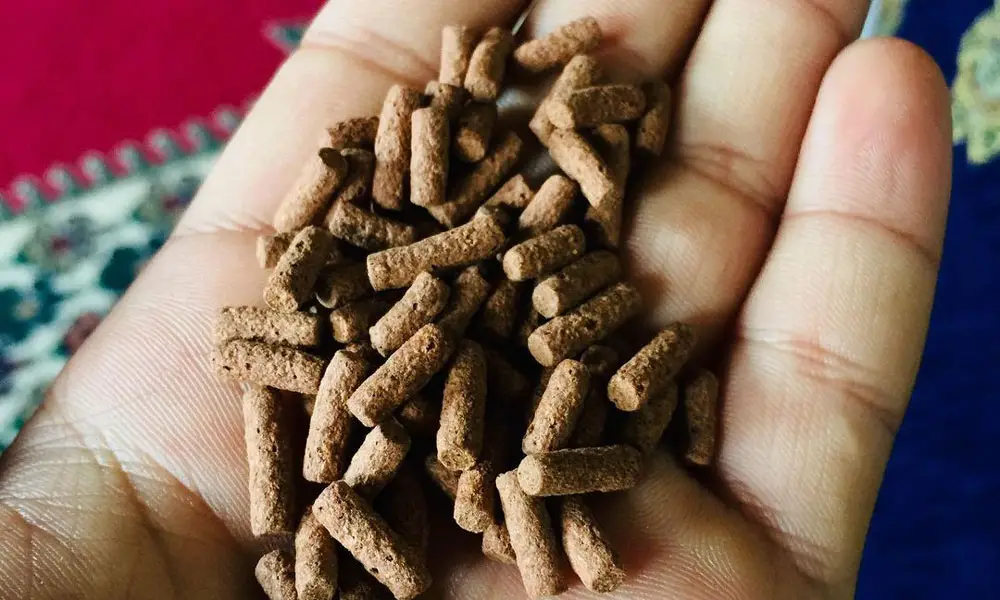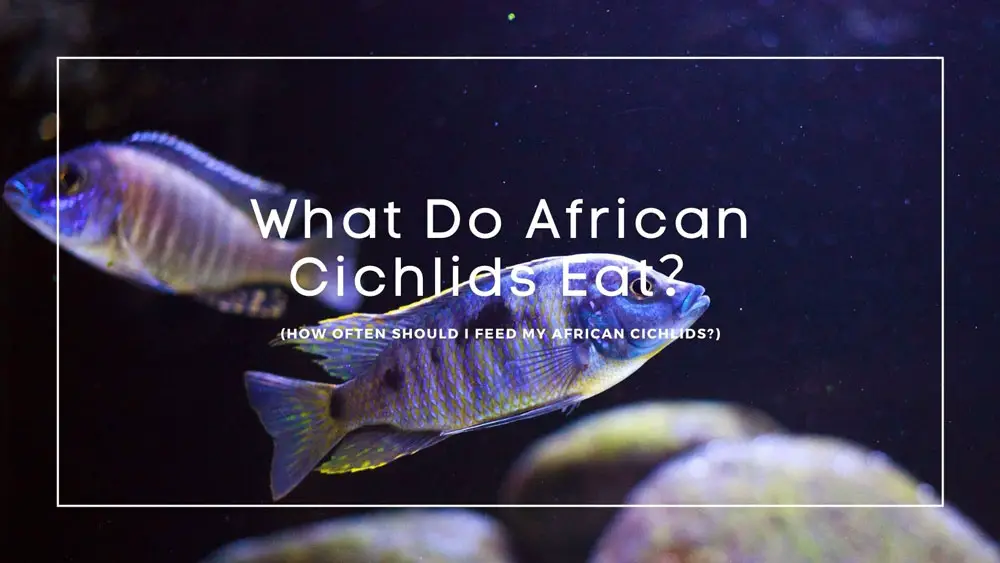Cichlids are perfect for aquarists because they are hardy and add color to an aquarium. However, just because they are resilient does not mean you can give them just about anything. Like all aquarium fishes, cichlids require a diet specific to their species.
If you have African cichlids, you might have issues on your hands when you renege on their nutrition. I learned that the hard way the first time I had African cichlids in my tank. I deem it appropriate to share my experiences so you can safely care for your African cichlids. So, what do African cichlids eat?
The information in this article may be the most important you will ever read about these fantastic animals. Let’s get started!
What Do African Cichlids Eat in the Wild?

African cichlids live in Africa’s Great Rift lakes, including Lake Tanganyika, Lake Malawi, and Lake Victoria. Hence, their food comes from whatever these lakes can give.
Depending on the species, African cichlids can eat small shrimp, other invertebrates, insect larvae, tiny snails, small fish, algae, and other plant materials in the wild. African cichlids cannot tolerate fatty foods because their digestive anatomies are not suitable for such macronutrients.
These have very specialized feeding habits, which is why these creatures can be so different in terms of what they eat.
What Do African Cichlids Eat in Aquariums?
It would be best to feed African cichlids the same food they get in their natural habitat to ensure optimum health. Unfortunately, it is often inconvenient to prepare an African cichlid-specific diet. Hence, most people use commercially available African cichlid foods.
Here is some advice on choosing the right food for your African cichlids.
Consider the Types of Cichlids
Choosing the right food for African cichlids requires determining whether the cichlid is a carnivore, omnivore, or herbivore.
Carnivorous
These African cichlids subsist on animal food sources, such as shrimp pellets and other animal-based cichlid food products. They have been known to attack and prey on other small species, especially their fry.
Most predatory African cichlids get between 8 and 12 inches (some even can grow over 18 inches), so they need a much larger aquarium of at least 250 gallons. If you wish to make an aggressive and carnivorous African Cichlid tank, cichlids from the Haplochromis group (Hap cichlids) are recommended.
- Dimidiochromis species
- Champsochromis species
- Buccochromis species
- Stigmatochromis species
- Tyrannochromis species
- Mylochromis species
- Nimbochromis species
- Cyrtocara moorii
- Exochromis anagenys
Herbivorous
Mbuna species are normally herbivores, thriving on algae and plants. These herbivorous cichlids are highly specialised scrapers.
Grazers comb algae using their slender tricuspid teeth, while browsers nibble and nip at filamentous algae with their bicuspid teeth. On the other hand, scrapers rub their chisel-like teeth across rock surfaces to feed on epiphyton. Some herbivorous African cichlids also bite and scoop algae.
High amounts of protein for herbivorous cichlids, such as frozen or live food, or even flake, can be pretty harmful and cause bloating, eventually leading to death.
Omnivore
The majority of African cichlids eat plant matter, small fish, insect larvae, and small invertebrates, such as brine shrimp and other small crustaceans.
Your cichlids will be happy with any of these three things. Give them a high-quality flake food or pellet every day, feed live brine shrimp (or frozen) as treats once per week – this is what keeps their immune system strong.
On the other hand, live guppies would be a good source when they get bigger. To greatly increase their color, foods rich in beta carotene can be helped.
Pellets or Flakes
Pellets are the go-to of many African cichlid owners. These fish species love to gobble pellets floating on the water’s surface. However, these food items sink to the bottom after some time. That is why some fish keepers prefer tropical flakes because they stay afloat. I also observed that African cichlids are more enthusiastic about eating flakes than pellets.
I recommend Spirulina flakes because they have excellent levels of protein, antioxidants, iron, chromium, and vitamin B12. African cichlids will benefit immensely from these nutrients.
- Spirulina is rich in raw protein
- For fresh or saltwater fish
- Enhances breeding
Frozen Food
If you have omnivorous, carnivorous, or piscivorous African cichlids, you might want to add frozen foods to their diets as treats. Excellent choices include black and white mosquito larvae, krill, and brine shrimp. However, I do not recommend giving red mosquito larvae and beef heart or products from other warm-blooded animals to Lake Malawi African cichlids.
Green Veggies and Fruits
People often ask me if they can give their African cichlids green veggies, fruits, and other homemade foods. I always tell them to feed their fish nori, cucumber, peas, broccoli, and lettuce. All of these green veggies are great for mbuna and their health. They can blend or chop these food items finely before freezing them into small pellet-sized cubes.
You can de-shell the peas or boil them for softer ones. I found cucumbers are a great way to keep your cichlids busy and entertained. They are also easy to prepare and store. Cut the cucumber in an inch-long chunk, attached to a flat rock or something heavy to weigh it down. Rember to take any uneaten cucumber out within 1-2 days.
Foods to Avoid Feeding Your African Cichlids
African cichlids are not picky eaters. However, it does not mean you can give them the same food you give to other aquarium fishes. Some food is a big no-no for African cichlids because of their unique digestive tracts.
Compared to South American and Asian cichlids, African cichlids have longer digestive tracts. The extended alimentary tubes can present some health problems to these fish species if we are not cautious about the food we give.
Seasoned aquarists do not recommend giving African cichlids bloodworms. While this meal might seem fine for other cichlid families and fish species, it can be disastrous to African cichlids. As mentioned, African cichlids have extended digestive tracts. Feeding them protein-rich foods can clog their intestines and lead to Malawi bloat. The extra-long intestines are inefficient in breaking down protein.
I once had a blue Nimbochromis polystigma, which my kid inadvertently fed protein-rich bloodworms. Its belly grew larger than usual. Unfortunately, it was too late for me to recognize the signs of bloating. The fish died after 3 days.
It would also be best to avoid giving African cichlids meat, beef heart, and other food items from warm-blooded animals. These food items have high-fat content with high melting points. Fishes have difficulty mobilizing fat stored in the liver for energy, leading to cirrhosis over time.
However, giving meat to African cichlids as rare snacks should be fine. I always caution beginner African cichlid keepers to observe moderation when giving treats to their aquatic pets. Feeding African cichlids with these food items as treats not more than once a week and in modest amounts should not cause problems for the fish.
How Often Should I Feed My African Cichlids?

I feed my adult African cichlids two to three times every day. Many African cichlid keepers also observe a similar feeding regimen. Newly born African cichlids (or fry) require five to seven feedings daily. It is essential to recognize that young African cichlids need smaller portions than adult species.
I find feeding my African cichlids helps reduce their aggressive tendencies. They are less territorial and will not likely attack other fish in the tank.
If you have herbivorous African cichlids, it would be best to feed them small portions two to three times a day. I always give my fish sufficient food they can consume in thirty seconds. These fishes have a voracious appetite. They can finish a meal within seconds. I remove any leftover afterward to avoid overfeeding.
Beginner African cichlid owners should know that these fish species love to rest at night. It would take about half an hour for African cichlids to transition from sleepy to active. Hence, I recommend turning on the aquarium tank at least 30 minutes before feeding. Likewise, it would be best to wait half an hour after feeding before turning off the light.
If you must travel like I sometimes do, you might want to invest in a high-quality automatic fish feeder. This machine dispenses the correct amounts of food to your African cichlids at pre-designated time intervals.
Final Thoughts
African cichlids have unique feeding preferences, habits, and patterns that some beginner aquatics hobbyists find confusing. These fishes eat almost anything in the wild. Keeping them in fish tanks requires a more systematic approach to ensuring their optimum nutrition.
High-quality African cichlid pellets and flakes are the best food for African cichlids kept in aquariums. Frozen foods, vegetables, and fruits can be healthy treats. It would also be best to avoid fatty animal food products to prevent health problems in African cichlids.







2 thoughts on “What Do African Cichlids Eat? (+How Often Should You Feed African Cichlids)”
Can you feed African Cichlids (Peacock) bananas, Zucchini or watermelon?
Hi Ian
In Lake Malawi, Peacocks (Aulonocara spp.) live in deep and dark water, few plants thrive in that condition. They are benthic insectivores, therefore they may not as a big fan of live vegetable plants like zucchini as Mbunas. Offering some Spirulina is enough to keep their blue color looking its best.
Hope this helps! 🙂
Jeff